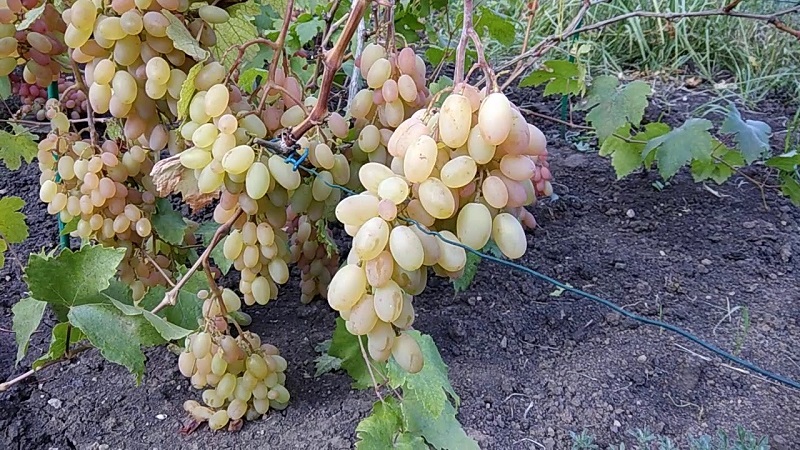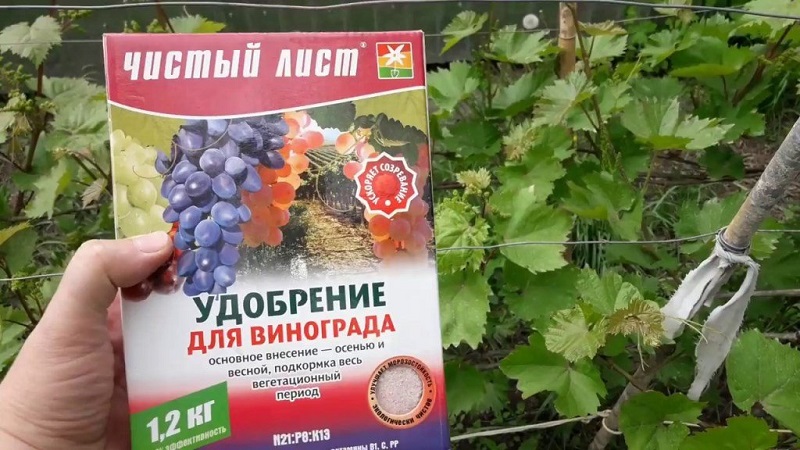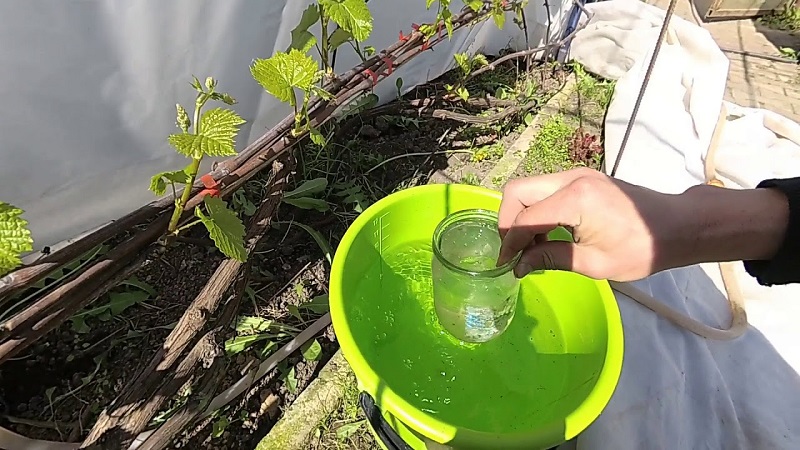How and how to feed grapes in June
The grape harvest will be good with proper care of this crop. Care for the vineyard begins in spring, but it does not stop in summer either. In June, the plant needs continuous care, including feeding. How and what to feed grapes in June, we will tell you in this article.
The content of the article
Do grapes need top dressing in June
June grapes blooms and actively grows shoots... At this stage, the plant needs a lot of strength for the future harvest. You can replenish them with fertilizers.

Is it obligatory
Since in June the vine is already forming the ovaries of future berries, it needs nutrients. It is convenient to fertilize grapes together with watering, since the plant also loves moisture.
Top dressing has a good effect on yields... They improve pollination and speed up the formation of bunches.
If you ignore the June top dressing, the quality of the crop will decrease., the berries will be small and dry, and the taste will not be as rich.
Also top dressing makes the vineyard more resistant to disease and pests.
What dressings do grapes need in June
At the beginning of summer grapes require a variety of nutrients and trace elements.
Useful material:
- Nitrogen increases berry size and shoot growth.
- Phosphorus promotes the growth and development of shrubs.
- Calcium is beneficial for the plant's root system.
- Potassium reduces ripening period of berries and gives them a sweet taste.
Trace elements:
- magnesium;
- zinc;
- copper;
- sulfur;
- iodine;
- boron;
- manganese.
Trace elements for the vineyard provide complex fertilizers.
When to feed grapes in June
They begin to feed the plant in early June, 2 weeks before flowering., the second time - right after it.
During the flowering period, fertilizers are not needed for the grapes. The third procedure is carried out at the end of the month, when the berries begin to ripen.
Fertilizers are applied in different ways, changing the number and composition of elements.
Read also:
Fertilization frequency and abundance
For the first time, the grapes are fertilized before flowering with a solution containing nitrogen, potassium and phosphorus... The mixture is infused for about 10 days and poured under the root. One plant requires 1-2 buckets of solution. Organic matter is also introduced - rotted manure or bird droppings (1 bucket per 1 sq. M).
Before the very beginning of flowering, microelements are added to the plant, using complex fertilizers, which must include boron and zinc. Trace elements are applied by spraying.
Immediately after flowering grapes are fertilized with a similar composition.
During the third feeding, nitrogen is excluded, leaving phosphorus and potassium, which are necessary for the formation and growth of berries. They also continue to add trace elements.
Reference. Nitrogen fertilizer can be replaced with 5% poultry manure solution or 10% mullein solution.
How to feed
Grapes require a lot of nutrients, therefore, mineral and organic fertilizers are used for feeding, as well as folk remedies.

Mineral fertilizers
Effective mineral fertilizers:
- Ammonium nitrate... Contains potassium and nitrogen. Use the composition in dry form, scattering in the near-stem circle. The quantity is indicated in the instructions on the package.
- Urea (carbamide)... The main composition of the product is nitrogen. An aqueous solution is prepared (15 g of urea per 10 l of water) and introduced under the root of the plant.
- Superphosphate... The main element of the composition is phosphorus. Available in granules. They are introduced into the soil at the rate of 40 g per 1 sq. m.
- Ammophos... Consists of phosphorus and ammonia. Available in three forms: granules, dry mix and concentrate. All forms are diluted with water according to the instructions. The granular composition is applied at the root, dry and concentrated spraying of plants is allowed.
- Potassium salt... Distribute the required amount of substance along the trunk circle and sprinkle it with earth on top. 1 bush takes 50 g of salt.
Work with mineral compounds in protective clothing.
Reference. It is not recommended to add superphosphate together with ammonium nitrate and carbamide.
Organic compounds
Organics are as effective for grapes as minerals.
Basic organic matter:
- Chicken droppings... It has the highest nitrogen content. The maximum effect is achieved when used in liquid form. Take 1 part of droppings to 10 parts of water, insist for a day and dilute again (2 liters of the mixture per bucket of water). An adult bush takes about 2 buckets. Rotted manure is used for fertilization in summer.
- Manure... Contains nitrogen, potassium, phosphorus, calcium and magnesium. For summer grapes it is also used rotted. Bred in the same way as chicken manure - 1:10.
- Compost, humus... In terms of nutrient content, it is not inferior to manure. The compositions are applied to the soil where the roots of the plant are located.
Folk remedies
Many growers prefer to use folk remedies to fertilize plants.
Effective folk recipes:
- Wood ash... The substance is sprinkled on the ground along the near-trunk circle. The second method is to prepare a solution: ¼ part of the ash is poured into a bucket, poured with water to the top and mixed. Plants are watered at the root.
- Yeast... For 10 liters of water, take 10 g of yeast, add 2 tablespoons of sugar and leave to ferment for 2 hours. For feeding, mix 1 part of the composition and 5 parts of water.
- Infusion of nettle... Fill the bucket to the top with chopped nettle and fill it with water. The mass is stirred daily for 6 days. Plants are watered at the rate of 1 liter of product per 10 liters of water.
- Ammonia... Water at the root using a concentration of 3 tbsp. l. alcohol per 5 liters of water.
- Boric acid... 2.5 g of boric acid powder is dissolved in 1 liter of water and the plant is sprayed.
These products give good results when applied before flowering.
Important! Before making any dressings, the soil is abundantly moistened.
The choice of top dressing in the Middle Lane
Grapes are a southern culture. To grow it in the middle lane Russia, fertilizers must be applied regularly.
For growing a good harvest, they are not limited to 1-2 types of dressings. Culture requires both minerals and organics.

In the Urals
Grapes take all the nutrients from the soil and impoverish it. Soil enriched only with organic matter is not able to completely nourish the plant; chemical fertilizers will be required.
Superphosphate, potassium chloride and ammonium nitrate are in demand from mineral dressings in the region.
In Siberia and other regions
The peculiarity of growing grapes in Siberia in the limitation of nitrogen fertilization... If the growth of green mass is greatly increased, the plant will not have time to prepare for wintering, therefore, the growth of the vine in the Siberian climate is limited. The culture is fed mainly with phosphorus and potash fertilizers, and is also sprayed with complex formulations and an extract from wood ash.
In the Moscow region, a culture requires a lot of feeding... The introduction of nitrogen, phosphorus, potassium, copper, magnesium, sulfur, iron, boron and zinc is mandatory. The drugs are used alone or in combination.
In the southern regions, organic matter and mineral fertilizers are used... From organic matter, manure is used, from minerals - superphosphates, carbamide, ammonium nitrate, potassium salt, potassium chloride.Suitable for the culture and complex fertilizers - ammophos, nitrophoska.
How to feed grapes
In order for the culture to grow well, develop and give a bountiful harvest, its fed in two ways... Together, they give good results.
In a root way
With this method, fertilizers are applied to the ground (usually in liquid form)... At the same time, avoid pouring the product directly under the trunk, since concentrated solutions can burn the roots. A trench is dug around the bush and the product is poured.
Since grapes have a very strong root system, they quickly suck out nutrients from the soil. Root feeding of the plant is carried out several times during the entire growing season.
The older the bush, the more often it needs the procedure.... Young vines have enough fertilizers laid during planting for the next 2 years.
In early summer, the culture is root-fed before flowering and when fruit ovaries appear. Nitrogen fertilizers or manure are applied before flowering. Phosphorus and potassium are added to the next top dressing.

Foliar
Foliar (leaf) feeding is carried out by spraying the vineyard... The procedure affects the development of the green mass of the bush and improves the crop yield. It is carried out regardless of how much root dressing was done and what means were used.
Foliar fertilize the plant before flowering mineral compositions, immediately after flowering - minerals and trace elements, at the beginning of fruit ripening - phosphorus and potassium.
Tips from experienced winegrowers
A beginner cannot always cope with such a capricious culture as grapes.
To help beginners, experienced growers willingly share tips on how to fertilize the plant.:
- Concentrated liquid feed should only be used in diluted form and in strict proportions. Better to add less, so as not to burn the roots of the plant.
- Those who use wood ash as top dressing need to consider the type of soil. It suits acidic soils well, but on alkaline soils it will harm.
- Foliar dressing is always an additional procedure. It is not enough for the normal development of the plant.
- Fertilizers should not be applied superficially to the soil. In this case, nitrogen will quickly evaporate, and potassium and phosphorus will not be able to reach the root system at the right time. To prevent this, the earth should be dug up.
- Do not use foliar fertilization in the open sun. This is done either in cloudy weather or in the evening after sunset.
Conclusion
Growing grapes is not easy. Its quality depends on how correct the care will be even before flowering. It is during this period that the plant especially needs nutrients.
In June, the vineyard will need several dressings, consisting of a complex of mineral and organic fertilizers. Their timely introduction and strict adherence to dosages will provide the grower with a plentiful and tasty berry harvest.